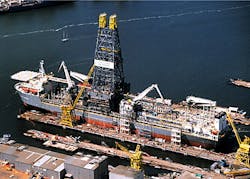The final touches are being put on the Discoverer Enterprise at Ingall's Pascagoula, Miss., shipyard. The vessel is expected to begin sea trials late this month. Photo by Danny Faulkner, courtesy of Transocean Offshore Inc.
Dean E. GaddyA dual-activity drillship, specially designed to perform simultaneous drilling operations, is expected to spud its first well later this summer in ultradeep water (see photo, this page).
Drilling Editor
Under a 5-year contract with BP Amoco plc, Transocean Offshore Inc.'s Discoverer Enterprise marks a distinct departure from conventional drillship design. In addition to two fully automated drilling packages, the multipurpose vessel will be able to drill, test, and complete wells to 35,000 ft in water depths up to 10,000 ft (OGJ, May 26, 1997, p. 69).
By the end of third quarter 2000, two more ultradeepwater vessels, built along the lines of the double-hulled Discoverer Enterprise, will join Transocean's existing fleet of three drillships. Of the 70 wells drilled so far in water depths exceeding 5,000 ft, Transocean has drilled 48 (see table [460,133 bytes], p. 27).
A fresh idea
Michael Wilburn, engineering manager for the Enterprise class of new-builds, said the concept behind the Enterprise class of drilling vessels is to reduce overall deepwater well costs: "The idea was to build two completely independent rotaries, traveling blocks, and everything else necessary for drilling operations, all under the same derrick." Thus, it will be possible to perform many operations concurrently, instead of sequentially, providing significant advantages for both exploratory and development operations ( see charts [131,767 bytes], p. 28)."We've taken a look at how much time it actually takes for an exploratory well, and, based on some preliminary studies, we save over a quarter of the time using the dual-activity rig as compared to a conventional drillship," said Forrest Estep, manager, drilling engineering, for Transocean.
Furthermore, additional time savings may be attained in batch-type operations.
"When you move it to the development scenario, when you're moving from well to well, we think we can save 40%, or even half the time, as compared with a conventional operation," Estep said.
For example, "You could be working on the second well while you're still latched up and drilling, testing, and completing the first well," Estep explained. Thus, operations can be set up so that the blowout preventer (BOP) and riser string are not constantly tripped back and forth to the surface between each well, cutting down on several days of rig time.
The critical path
On the Discoverer Enterprise, the forward and aft rotary tables will support each other in an orchestrated manner that maximizes progress along the critical path. For example, in an exploratory or single-well scenario, the forward rotary can be used to prepare and run the BOP stack and riser at the same time that the aft rotary spuds the well and installs the conductor and surface casing strings.Then, once the 20-in. casing string is cemented, the critical path moves from the aft rotary to the forward rotary as the riser and BOP stack, already run down to the seabed, is landed on the wellhead. This type of dual activity is facilitated by dynamically repositioning the drill ship.
"Some ships that have the ability to make up tubulars off-line can only do so above the water line," said Wilburn. "Once they get the tubulars racked back in the derrick, they still have to go through a single rotary." Thus, on those vessels, it is impossible to drill with one rotary and simultaneously run riser with another.
From this point, the aft rotary table converts to a full support role for the forward rotary table, eliminating operations from the critical path and reducing the time required for performing sequential operations. "We'll be doing things like making up tubulars, getting ready to run the next casing string, and picking up drill pipe for the next hole section, and so on," Estep said.
For example, as the 171/2-in. hole is drilled with the forward rotary (now on the critical path), the aft rotary side will pick up the 133/8 and 95/8-in. casing joints, make them up into 120-ft long stands, and rack them back in the derrick. This off-line activity serves to reduce the time needed to run casing once total depth is reached, continuing onward as the hole progresses to smaller casing strings.
Other advantages
The upside for a dual-activity drillship has yet to be exploited. For example, if government regulations outlawed gas flaring, an injection well drilled with the aft rotary could allow for well-testing and cleanup.Other applications that can be incorporated into the well construction process, primarily outside of the critical path, include:
- Running subsea trees to the seafloor while working through the BOP.
- Running a flow line anchor pile.
- Running pipeline base.
- Running flow line jumpers.
- Washing hydrates off a BOP stack or tree.
- Clearing a cuttings mound away from the well.
- Running flow lines and pipelines.
- Drilling a water injection well for long-term test.
- Drilling a cuttings injection well.
- Having two risers and BOPs deployed and drilling on a template.
- Using a vertical separator to collect liquids from gas well.
Copyright 1999 Oil & Gas Journal. All Rights Reserved.


